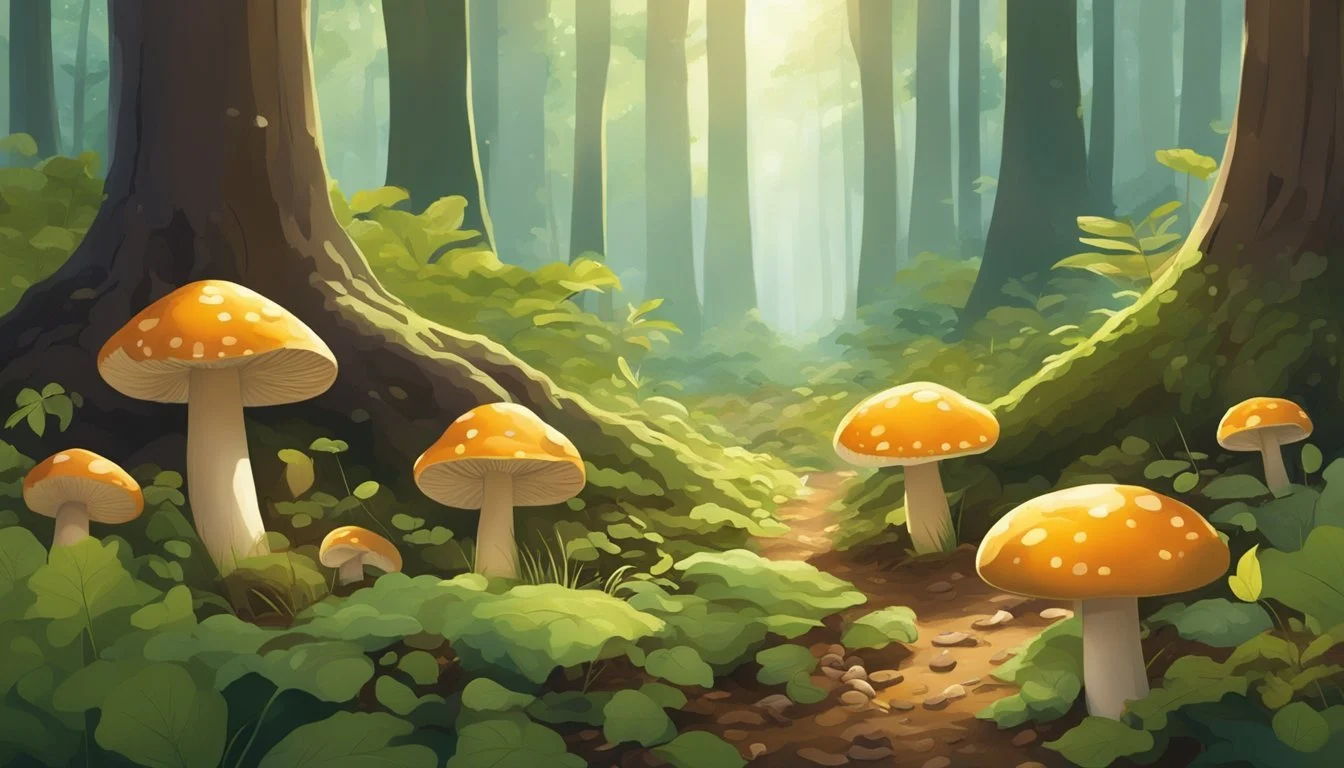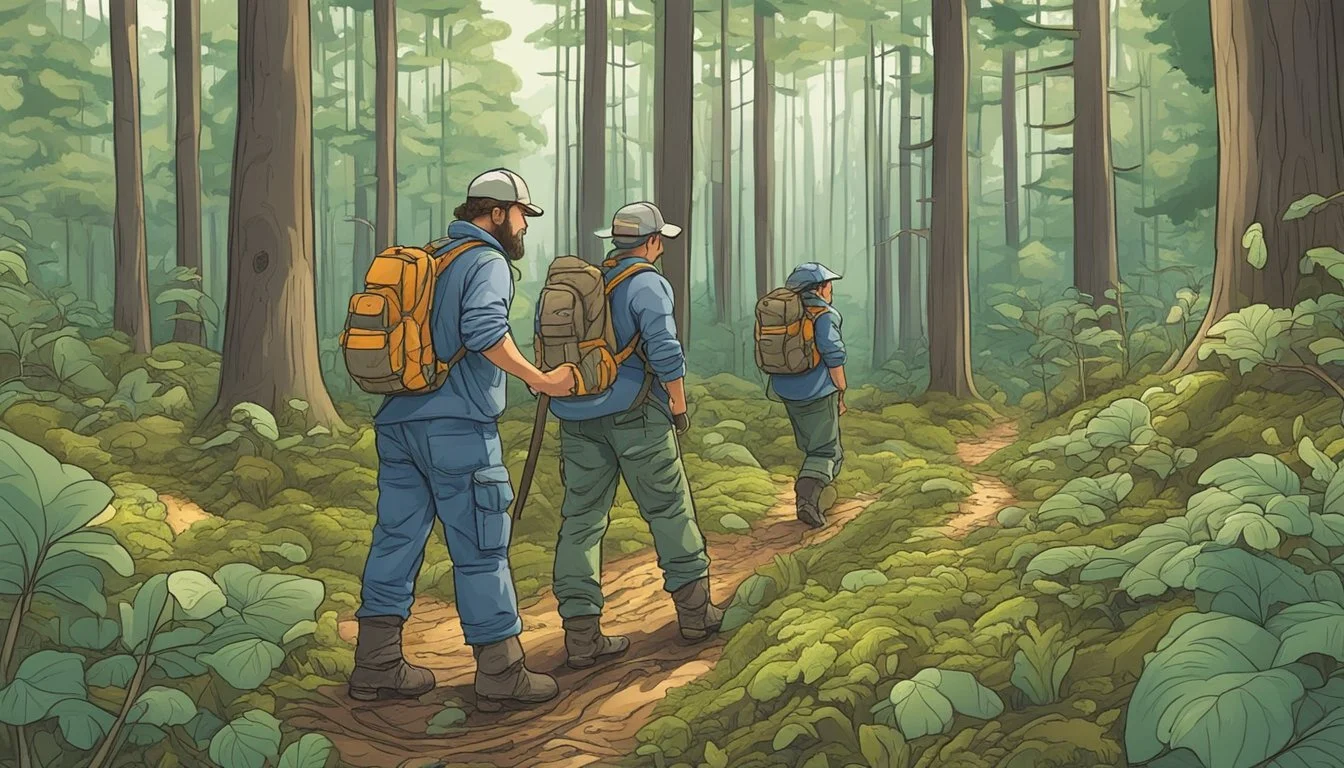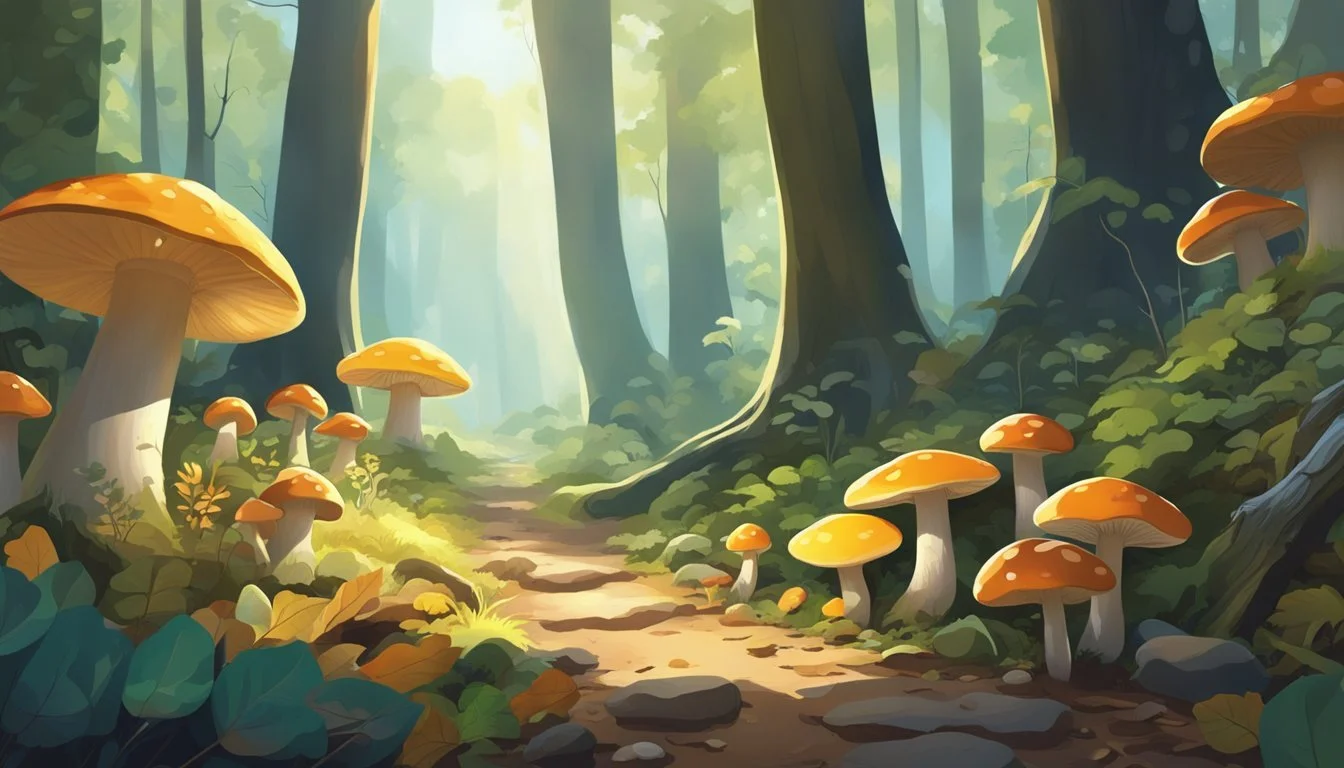Mushroom Hunting Arkansas
A Guide to Safe Foraging Practices
This Article is Part of Our Guide on Mushroom Hunting for All 50 States
Mushroom hunting in Arkansas offers a rich experience for foragers and nature enthusiasts alike. The state's diverse ecosystems provide a variety of habitats where a range of mushroom species thrive. As the seasons change, so do the opportunities for mushroom hunting, with each period presenting its own unique set of fungi. In the spring, hunters eagerly seek the elusive morels, prized for their unique flavor and rarity. These spongy-capped mushrooms are often found in wooded areas, particularly among certain trees like elms, ashes, and poplars.
With the onset of fall, conditions become ideal as the combination of warm days and cool nights encourages the growth of a wider assortment of mushrooms. It's during this time that forests and even backyards can reveal surprises like chanterelles, known for their delicate taste and distinct, ruffled edges. Regardless of the season, those interested in foraging for mushrooms in Arkansas should equip themselves with a thorough understanding of the local species, their preferred conditions, and importantly, knowledge of which mushrooms are safe to consume to avoid the risks of poisonous look-alikes.
Foraging for More Than Just Mushrooms in Arkansas
Arkansas' lush forests and diverse landscapes, from the Ozark Mountains to the Mississippi Delta, offer a wealth of wild edibles for the curious forager. While mushrooms are a popular find, the Natural State's rich ecosystems provide a bounty of berries, nuts, greens, and roots. Discover the joys of foraging and immerse yourself in nature's abundance in Arkansas' picturesque wilderness, from the rolling hills of the Ouachita National Forest to the swampy bottomlands of the White River.
👉 Foraging for Wild Edibles in Arkansas
Commonly Found Edible Mushrooms in Arkansas
Arkansas is home to several edible mushroom species. Some of the most commonly found edible mushrooms in the state include:
Morel (Morchella spp): This highly prized edible mushroom is commonly found in Arkansas and has a distinct honeycomb appearance with a nutty, earthy flavor.
Chanterelle (Cantharellus spp): Highly sought after for its fruity aroma and peppery flavor, this golden mushroom is commonly found in Arkansas and is a favorite among foragers and chefs.
Chicken of the woods (Laetiporus sulphureus): With its vibrant orange color and lemony, meaty flavor, this mushroom is frequently found in Arkansas and is popular for culinary use.
Button mushroom (Agaricus bisporus): Widely cultivated and commonly found in Arkansas, this mushroom has a mild flavor and is used in a variety of dishes.
Oyster Mushrooms (Pleurotus spp): These white to pale grey mushrooms grow on the sides of trees and have a distinct shell-like shape.
Puffballs (Calvatia, Lycoperdon, and Bovista spp): True to their name, these globe-like mushrooms can be quite large and are white inside when edible.
Bolete (Boletus edulis): This group of mushrooms is identified by their sponge-like layer under the cap instead of gills.
Lion’s Mane (Hericium erinaceus): With long, shaggy spines, they are known for their rich, crab (how long does crab last?)-like flavor when cooked.
Black Trumpet (Craterellus cornucopioides): These horn-shaped mushrooms are somewhat elusive but considered a delicacy.
It is essential to properly identify any mushroom before consuming it, as some species can be poisonous. Beginners should go mushroom hunting with an experienced guide or join a local mycological society to learn how to identify edible mushrooms safely.
The Basics of Mushroom Hunting in Arkansas
Arkansas offers a diverse range of mushrooms for foragers, from Chanterelles to Turkey Tails. This section covers the essential aspects of mushroom hunting in the state, focusing on local fungi knowledge and applicable laws.
Understanding the Local Fungi
Arkansas's woods and forests are a haven for a variety of mushrooms, some of which are highly sought after by foragers. A few notable varieties include:
Chanterelle: Distinctive for its yellow to orange color and vase-like shape.
Oyster Mushrooms: Easily identified by their oyster-shaped caps and are usually found on the sides of trees.
Puffballs: These can be spotted by their round, ball-like appearance when young.
Indigo Milk Cap: Noteworthy for its blue color and the milk-like substance it exudes.
Black Trumpet: A type of chanterelle that’s darker and has a trumpet-like shape.
Foragers should invest time in educating themselves on the identifying features of these fungi, as it's crucial for safe mushroom hunting. They are often found in areas with specific soil compositions, within certain forest types, or at optimal times of the year.
Foraging Laws and Regulations
Before embarking on a foraging expedition, individuals must be aware of the laws governing such activities in Arkansas. Here's what one should know:
Public Lands: Foraging on public lands may require permits or be subject to restrictions, so always check local rules.
Private Properties: Foraging on private property is only legal with express permission from the owner.
Conservation Areas: Some areas may have protected species or ecosystems, so foraging could be prohibited.
Important Note: Always consult the Arkansas Department of Natural Resources or local authorities for the most current foraging regulations.
An understanding of the laws is imperative to ensure that foraging is done legally and sustainably. Responsible foragers contribute to the conservation of Arkansas's natural habitats and ensure that these resources remain abundant for future generations.
Ideal Environments for Mushroom Growth
Mushroom hunters in Arkansas are served well by understanding the key factors contributing to ideal fungal proliferation. These factors include suitable soil characteristics, compatible tree species, and favorable climatic conditions throughout varied seasons.
Soil and Topography
Mushrooms thrive in soil rich in organic matter with the right balance of moisture and nutrients. The topography of an area greatly influences these soil conditions. For instance, mushrooms often flourish in woodland areas where humous-rich soil is prevalent. Key factors to consider in soil composition include:
Soil Type: Loamy and sandy soils that ensure good drainage and aeration.
Acidity: A slightly acidic to neutral pH is often preferred by many mushroom species.
Aspect and Topography: Slopes and hillsides with northern exposure may retain moisture and offer shelter from intense sunlight, aiding in mushroom growth.
Trees and Forests
The relationship between fungi and trees is symbiotic, with certain mushrooms favoring specific host trees. Forested regions, particularly the Ozark Mountains, provide diversified ecosystems that support a variety of mushroom species. Important aspects encompass:
Types of Trees: Hardwoods like oaks and hickories are often associated with morels, while pines and firs may harbor different species.
Forest Health: Healthy, mature forests are more likely to have a complex understory that supports a rich fungal community.
Climate and Seasons
Mushrooms require certain climate conditions for optimal growth. Seasonal changes in Arkansas bring varied opportunities for mushroom hunters:
Rainfall: Adequate rain, especially during spring and fall, moistens the soil, creating conducive growth conditions.
Temperature: Morels, for instance, emerge when daytime temperatures reach the 60's (°F) and nighttime temperatures are in the upper 40's (°F), with ground temperatures in the low to mid 50's (°F).
Seasons: Each season can bring a new crop of mushrooms; for instance, morels in early spring, chanterelles in summer, and oysters in the cooler months.
Common and Edible Mushrooms in Arkansas
This segment focuses on the prevalent and consumable mushrooms found in Arkansas, detailing identification methods and outlining those to steer clear of due to toxicity.
Identification Tips
Confirm the presence of a sponge-like layer for boletes; avoid those with red or orange pores, as some are toxic.
Look for the false gills on chanterelles; they should be shallow and forked, not blade-like as with toxic look-alikes.
Morels should have a hollow interior from the tip of the cap to the bottom of the stem. False morels, which are poisonous, often have cotton-like fibers inside.
Oyster mushrooms should have gills running all the way down the stem, a feature not found on similar toxic mushrooms.
Toxic and Poisonous Mushrooms to Avoid
Destroying Angel (Amanita sp.): White with a smooth cap and a bulbous or skirt-like ring on the stem. Highly toxic, even lethal.
Fly Agaric (Amanita muscaria): Iconic red cap with white spots; though often associated with enchantment lore, they are dangerous to consume.
Jack O'lantern: These orange to yellow mushrooms grow in clusters on wood and are poisonous, not to be mistaken with the edible chanterelles.
Deadly Webcaps: These can resemble edible varieties but carry a risk of kidney and liver failure.
Mushroom Foraging Techniques and Practices
Mushroom hunting in Arkansas is an activity that combines outdoor adventure with the prospect of delicious rewards. The following techniques and practices are integral for both novice and seasoned foragers to enhance their hunting experience and ensure safety and success.
Searching Strategies
Foragers often use their knowledge of local ecosystems to locate mushrooms. Each species has a preferred habitat, so understanding the environment is key. Hardwood forests are prime locations for species like the Chicken of the Woods, especially from June through November. Experts recommend looking near trees like oaks and elms, particularly for morels in April, a favored month for this coveted species.
Best Times to Hunt
The mushroom hunting season typically spans from late summer to early winter. Foragers should plan their excursions after rainfall, when mushrooms are more likely to emerge. Early morning is often the best time, as it allows hunters to beat the heat of the day and pick mushrooms when they're freshest.
Safety and Precautions
Safety in mushroom hunting cannot be overstated. Foragers must ensure they have permission to hunt on private property or understand the legal considerations for foraging on public land. Accurate identification is crucial to avoid toxic species—when in doubt, it is best to leave a mushroom untouched. Carrying a field guide or consulting with experts can help in correct species identification.
Equipment and Gear
The right gear can make a substantial difference in a forager's outing. Essential equipment includes:
A basket or mesh bag to allow spores to disperse.
A sharp knife for clean cutting, which helps preserve the fungi's mycelium for future growth.
Comfortable, weather-appropriate clothing and sturdy footwear are important for navigating through forests and fields.
Consider a hand lens or magnifier for examining small features that are critical for identifying different mushroom species.
By adhering to these strategies, practicing safety, and using the proper equipment, foragers can enjoy the bountiful mushroom spots in Arkansas responsibly and sustainably.
Culinary Uses and Preparation of Mushrooms
In Arkansas, mushroom enthusiasts find a variety of edible species that can enhance any meal with their distinct flavors and textures. The preparation of these mushrooms is critical to maximizing their culinary potential.
Cooking and Recipes
Cooking with mushrooms offers a plethora of options, from simple to sophisticated. Certain mushrooms, like the flavorful Lobster Mushroom, boast a firm, seafood-like texture making it ideal for sautéing or incorporating into seafood dishes. (What wine goes well with seafood dishes?) They provide a vibrant orange-red color that can brighten up any plate.
When considering recipes, Ringless Honey Mushrooms offer a golden, honey-colored cap that can be a delightful addition to stews and stir-fries. Their nutty flavor pairs well with both vegetable and protein ingredients. For mushrooms like these, one could prepare them by:
Slicing thinly for use in salads or stir-fries.
Sautéing with garlic and herbs until golden brown to serve as a side dish.
Frying in light batter to create a crispy appetizer.
Preservation Methods
Preserving mushrooms ensures their unique flavors can be savored year-round. The key methods include drying, pickling, and freezing. Each method has its own appropriate application depending on the mushroom species and intended culinary use.
Drying: Suitable for most species, such as the Honey (how long does honey last?) Mushroom, drying concentrates the flavor and allows for long-term storage. Dried mushrooms (how long do dried mushrooms last?) can then be rehydrated by soaking in water.
Mushrooms Drying Method Usage Honey Mushroom Air-dry or use dehydrator Soups, stews, rehydrated
Pickling: This method works well with meaty mushrooms and provides a tangy flavor. Pickled mushrooms can be a zesty garnish or a standalone snack.
Mushrooms Pickling Liquid Components Storage Life Meaty types Vinegar, water, spices, and herbs Up to 1 year
Freezing: After blanching, freeze mushrooms like Honey or Lobster Mushrooms in airtight containers. Frozen mushrooms are best used in cooked dishes as they may become soft upon thawing.
Mushrooms Preparation for Freezing Best Used in Lobster (What wine goes well with lobster?) and Honey types Clean, blanch, and flash-freeze Cooked recipes
Arkansas’s Mycology Resources
Arkansas offers an array of resources for enthusiasts interested in mushroom foraging, from local societies to educational opportunities and active online communities.
Local Mycological Societies
The Arkansas Mycological Society stands prominent as they facilitate the study and enjoyment of fungi. Founded in 1981, it has since grown to foster a community of mycology enthusiasts. The society organizes forays, meetings, and provides a platform for networking with experts in the field.
Educational Workshops and Classes
For those seeking a more structured learning environment, the Arkansas Mycological Society often hosts educational workshops and classes. These sessions are typically led by knowledgeable mycologists and offer hands-on experience in identifying and foraging mushrooms. Additionally, state parks and nature centers may also offer seasonal classes and forays guided by local experts.
Online Communities and Groups
Online platforms serve as a vital resource for mushroom hunters in Arkansas. Notably, a dedicated Facebook group associated with the Arkansas Mycological Society provides a space for over 5,000 members to discuss findings, share tips, and seek advice on mushroom identification. Here, both amateurs and experts come together to enhance their understanding of Arkansas's fungal biodiversity.
Challenges and Considerations in Mushroom Hunting
Mushroom hunting poses various challenges and considerations to ensure sustainability, legality, and safety. From environmental to legal and ethical factors, one must navigate these concerns with attention and respect.
Environmental Concerns
When foraging, the environmental impact is a crucial aspect to consider. Habitats should be left undisturbed to allow fungal networks to thrive for future yields. Overharvesting poses a risk to these delicate ecosystems. It's imperative to:
Recognize and preserve mycelium health by harvesting mushrooms without disturbing the surrounding area.
Understand that specific growth conditions are essential for mushrooms, making it vital to track seasonal patterns for sustainable foraging.
Legal Aspects
Foraging laws vary by region and must be followed closely. Gathering mushrooms on private property without permission is illegal and disrespectful to landowners. Key legal stipulations include:
Always obtaining necessary permits or permissions before foraging.
Being aware of state-specific regulations that govern the collection of wild mushrooms.
Ethical Foraging
Ethical considerations underline the proper conduct in foraging. Respecting nature and future harvests are at the forefront of ethical foraging. A forager must:
Use clean, sharp tools to cut mushrooms, avoiding harm to the mycelium.
Avoid collecting rare or over-harvested species to prevent depleting local populations.
Understanding Mushroom Ecology
Mushroom hunting in Arkansas requires knowledge of the ecosystem where fungi thrive. One must grasp the basics of fungal biology and the delicate balance within their habitats.
Fungal Life Cycles and Reproduction
Fungi are a unique kingdom of organisms that reproduce through spores, often invisible to the naked eye. The life cycle of a fungus begins with the release of these spores, which, when landing in an ideal environment, germinate and grow into new fungal networks called mycelium. This mycelium is the main life form of the fungus, with the mushrooms themselves being the fruiting body meant for spore dissemination.
Interactions with Other Species
Fungi interact with other species in a myriad of ways:
Mutualistic Relationships: Many fungi form symbiotic associations known as mycorrhizae with plant roots. These relationships are beneficial to both parties—fungi receive carbohydrates from the plants while aiding plants in nutrient absorption from the soil.
Decomposers: Some fungal species are responsible for breaking down dead organic matter, recycling nutrients back into the ecosystem.
Pathogens and Parasites: Certain fungi can be harmful to other species, acting as pathogens to plants, animals, and even humans.
In the context of Arkansas, mushroom hunters should respect these interactions to maintain the ecological balance during their foraging activities.





